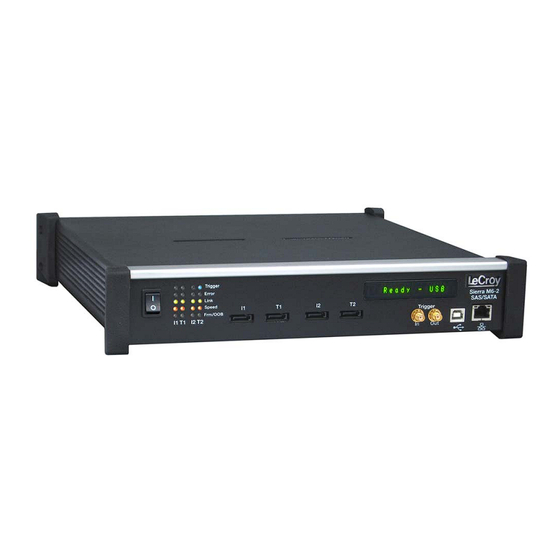
LeCroy Sierra M6-2 Manuals
Manuals and User Guides for LeCroy Sierra M6-2. We have 1 LeCroy Sierra M6-2 manual available for free PDF download: User Manual
LeCroy Sierra M6-2 User Manual (480 pages)
SAS/SATA Protocol Analyzer
Brand: LeCroy
|
Category: Measuring Instruments
|
Size: 12 MB
Table of Contents
-
-
Leds21
-
-
Port Status40
-
Data Report40
-
Infusion40
-
Trainer41
-
-
Main Window43
-
Project Tree45
-
Run Hardware47
-
Exporting50
-
Projects54
-
-
-
Timeout76
-
Symbol77
-
Primitive78
-
ATA Command79
-
Atapi80
-
Data Pattern81
-
-
Timer91
-
-
Pre-Trigger93
-
-
Memory Size95
-
-
Project Settings111
-
Notes111
-
-
-
-
Adding a Frame117
-
Adding an Event118
-
Data Blocks125
-
Record and Play127
-
Project Settings152
-
Run Hardware163
-
-
Pages Tab163
-
Notes Tab186
-
Project Note191
-
-
-
Viewer Display193
-
Quick View194
-
-
Switching Views196
-
Text View197
-
Column View198
-
-
Rename Port199
-
Show/Hide Field200
-
Related Frames201
-
Byte Order202
-
Show All Data203
-
-
Field List View204
-
Waveform Display211
-
Port Status216
-
Toolbars217
-
Main Toolbar217
-
Status Bar224
-
Search Status224
-
-
Filtering224
-
-
Cursors235
-
-
Search240
-
Search by242
-
Search Direction242
-
Search from242
-
Search Logic243
-
Search for243
-
Search Domain243
-
Search Sub Items244
-
Set Port Alias250
-
Tx Vout253
-
-
General Tab254
-
Paths254
-
Template Files255
-
Other255
-
-
-
Optimization256
-
Other257
-
-
Color Setting258
-
Other258
-
-
Column View Tab259
-
Other259
-
-
-
Other260
-
-
Floating License263
-
USB IP Setup267
-
Help Menu270
-
Help Topics270
-
Update License270
-
About270
-
-
-
Report Options273
-
General Report274
-
Primitive Report274
-
ATAPI Report276
-
Others Report277
-
-
Data Report295
-
Tools296
-
Self Test296
-
Clock Check297
-
Memory Check298
-
Serdes Check299
-
Crosspoint Check300
-
Expansion Check302
-
Led/Buzzer Check303
-
-
Find Device304
-
-
-
-
Key Features316
-
Interface317
-
Buttons317
-
Menus318
-
Main Library319
-
Device Library320
-
Device Ports321
-
-
-
Global Rules327
-
Sequences328
-
-
-
Main Library329
-
File Libraries329
-
Device Libraries330
-
-
Scenario Events334
-
DWORD Matcher336
-
SAS Data Pattern336
-
-
Scenario Actions337
-
-
-
Script Workspace370
-
Error Checking373
-
Log373
-
Statements373
-
Ifisstopped373
-
Goto Label374
-
Run375
-
Stop376
-
Waitforstop377
-
Sleep378
-
Beep378
-
-
-
-
-
-
File Menu380
-
Setup Menu381
-
Generate Menu382
-
Search Menu382
-
View Menu384
-
Tools Menu384
-
Window Menu385
-
Help Menu385
-
-
-
Layout390
-
-
-
Pop-Up Menu398
-
File Tabs398
-
Error Log399
-
Tooltips399
-
-
File Structure402
-
Language402
-
Settings403
-
Constants403
-
Data Patterns403
-
Primitives404
-
Packets/ Frames404
-
Generation Block407
-
Definitions407
-
-
-
General Commands415
-
SATA Commands417
-
Wait Commands421
-
-
-
Cell Pop-Up Menu444
-
Find449
-
Find Next452
-
Search Direction452
-
Display Options452
-
-
-
WAN Operation466
-
-
-
Index469
-
Advertisement
